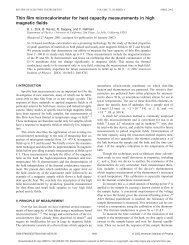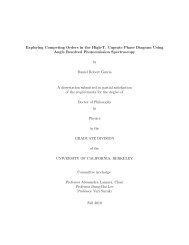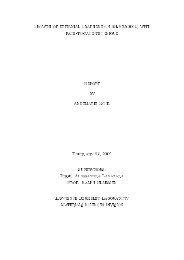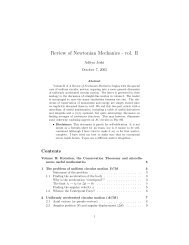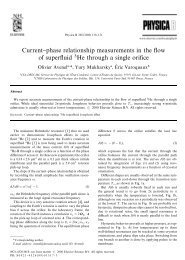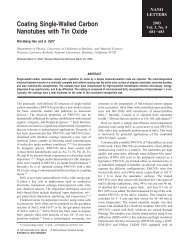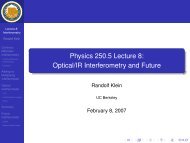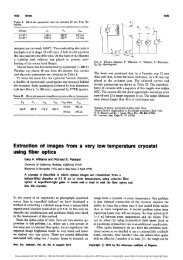Dirac Fermions in Graphene and Graphiteâa view from angle ...
Dirac Fermions in Graphene and Graphiteâa view from angle ...
Dirac Fermions in Graphene and Graphiteâa view from angle ...
Create successful ePaper yourself
Turn your PDF publications into a flip-book with our unique Google optimized e-Paper software.
Chapter 2<br />
Experimental techniques<br />
2.1 Angle resolved photoemission spectroscopy (ARPES)<br />
2.1.1 ARPES <strong>and</strong> the photoelectric effect<br />
Photoemission describes the ejection of electrons <strong>from</strong> a metal when a beam of light is sh<strong>in</strong>e on the<br />
clean surface. It was discovered by Hertz <strong>in</strong> 1887 <strong>and</strong> expla<strong>in</strong>ed by E<strong>in</strong>ste<strong>in</strong> <strong>in</strong> 1905. The photoelectric effect<br />
was very puzzl<strong>in</strong>g when it was first discovered, with a few mysterious key po<strong>in</strong>ts. First, the electrons were<br />
emitted immediately. Second, <strong>in</strong>creas<strong>in</strong>g the <strong>in</strong>tensity of the light <strong>in</strong>creases the number of photoelectrons,<br />
but not their maximum k<strong>in</strong>etic energy. Third, red light will not cause ejection of electrons, no matter how<br />
strong it is. Fourth, a weak violet light will eject only a small amount of electrons, but their maximum<br />
k<strong>in</strong>etic energies are larger than those ejected by <strong>in</strong>tense light of longer wavelength. These results cannot<br />
be expla<strong>in</strong>ed without <strong>in</strong>vok<strong>in</strong>g the quantum nature of light, the wave-particle duality. E<strong>in</strong>ste<strong>in</strong> postulated<br />
that light is quantized <strong>and</strong> that each quanta photon carried energy hν. The maximum k<strong>in</strong>etic energy of the<br />
photoelectrons is<br />
E max = hν − φ, (2.1)<br />
where φ (typically 4 to 5 eV for most materials) is the work function of the materials, i.e. the m<strong>in</strong>imum<br />
energy needed to excite an electron <strong>in</strong>to the vacuum. In E<strong>in</strong>ste<strong>in</strong>’s theory, light is not just a particle <strong>and</strong> not<br />
just a wave: it can be one or the other, depend<strong>in</strong>g on how it is measured. For his explanation of photoelectric<br />
effect, E<strong>in</strong>ste<strong>in</strong> was awarded the Nobel prize <strong>in</strong> 1921.<br />
It was later realized that photoelectric effect could provide useful <strong>in</strong>formation about the electronic<br />
states <strong>in</strong>side the materials. As a result of energy conservation, the energy distribution of photoelectrons<br />
can provide <strong>in</strong>formation about the density of states <strong>in</strong> the material studied 14 . Started <strong>from</strong> 1960’s, it was<br />
realized that momentum dependent b<strong>and</strong> structure could be mapped <strong>from</strong> the <strong>angle</strong> <strong>and</strong> energy dependence<br />
of the photoemission spectra <strong>and</strong> the first <strong>angle</strong> resolved photoemission was demonstrated <strong>in</strong> 1974 15,16 .<br />
This technique, today known as <strong>angle</strong> resolved photoemission spectroscopy (ARPES) is among the most<br />
powerful spectroscopic techniques as it provides direct <strong>in</strong>formation on the electronic b<strong>in</strong>d<strong>in</strong>g energy <strong>and</strong> the<br />
crystal momentum of solids. A schematic draw<strong>in</strong>g of the experimental setup used <strong>in</strong> ARPES experiment<br />
<strong>and</strong> typical data set is shown <strong>in</strong> Fig. 2.1. Information on Fermi surface topology <strong>and</strong> b<strong>and</strong> structure can be<br />
directly extracted <strong>from</strong> the peak position of the photoemitted electrons as a function of energy <strong>and</strong> <strong>angle</strong> of<br />
emission (momentum). As a result of the uncerta<strong>in</strong>ty pr<strong>in</strong>ciple, the width of the ARPES peak can also give<br />
8





